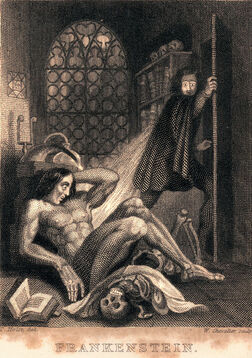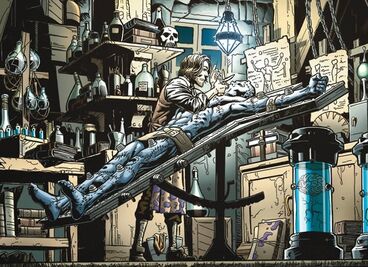Ingolstadt, Germany[]
Ingolstadt- General Information[]

The Ingolstadter Alte Anatomie (Old Anatomy Building) on the campus of the University of Ingolstadt.
Ingolstadt is a fortified university city that lies in the Bavarian state of Southern Germany. The municipal lies along two rivers, the Danube and Schutter. The University of Ingolstadt was founded under the patronage of the Duke of Bavaria, Ludwig the Wealthy. Ingolstadt is the fourth largest city in Germany, following Munich, Nuremberg, and Augsburg. Ingolstadt began as a fort city, therefore it is surrounded by a medieval wall, which now surrounds a museum of the city. The university was considered the medical and scientific center of Europe, which housed the principal establishment specializing in anatomy and biology, The Ingolstadter Alte Anatomie (Old Anatomy Building). Ingolstadt holds ties to the beginnings of Jacobinism and the French Revolution.
Strategic Positioning
The strategic location of Ingolstadt was too important for any leader to ignore. During the 15th century, the city was located in the “northwest border of Bavaria on strategic roads between Munich and Nuremburg as well as between Ulm and Regensburg.” (Dominik) Since the city was positioned at the crossroads of many routes, while sitting on top of the Danube River, many fortifications were needed to protect the bridge that connected all these great cities. The leaders of the city developed fortifications that included new moats and citadels that surrounded the already established medieval walls that served well during the Thirty Years War (1618-1648). After the tyrant known as Napoleon Bonaparte conquered Europe for the first time, the French moved into the fortified city. As they occupied Ingolstadt, they saw no need to keep the fortifications and intended to destroy them, however Napoleon’s reign did not last long. Twenty years after Napoleon’s defeat and exile a new classicist-style fortress was erected. During the 19th century, the university was transferred out of the city to Landshut, which lead to the construction of the Bavarian fortifications of today. Twenty thousand men were enlisted to help construct the blueprints of Leo Von Klenze, which included the intimidating Kavaliers (a type of bastion), barracks, casemates, outworks, and carriage houses. During this time other fortifications like “The Glacis” (a green girdle that encircles the Old Town) and the “Schanz” (a series of fortifications) are still defining features of the city. (Ingolgstadt Tourism)
The University of Ingolstadt
Ingolstadt was not only a strategic fortified city, but also a location that held the highest standard for the academia world of the time. It boasted one of the most prestigious universities that the world could offer through the ages. The University of Ingolstadt was first opened on July 26th, 1472 thanks to the support of Ludwig the Rich. It had approximately 400-450 enrolled students who were taught by a faculty that was philosophically Jesuit. The first faculties were held in the “Hohe shule” (High School). These faculties included areas of study in the humanities, science, theology, law, and medicine. The university expanded further during the 18th century by adding an anatomy theater, a botanical garden, and a chemistry laboratory. One of the major renovations of the expansion was the demonstration hall in the central atrium, which was “converted into a two-story anatomical theater, with a dissecting table on the ground floor, a gallery for student observers above, and a glass ceiling allowing overhead illumination.” (Curran) The university had great pride in their ability to become one of the top medical institutions of Europe with some of the finest facilities known to man. Ingolstadt’s university remained a top choice for students of knowledge, but only until the year of 1800 when it was relocated to Landshut and then later to Munich in 1826, where it currently resides.
A Setting of Substance[]
“Life and death appeared to me ideal bounds, which I should first break through, and pour a torrent of light into our dark world." (Shelley 34).

Victor and the Creature during the creation scene at the University of Ingolstadt.
At the time of Frankenstein’s birth, the University of Ingolstadt in Bavaria, Germany, a well-known medical school, would have been equipped to support Victor’s scientific experiments. Not only did Ingolstadt provide the perfect setting as the home of the medical university, but also provided the mystery needed as the home of the Order of the Illuminati.
The Illuminati was reported to be a secret society founded in Ingolstadt, specifically the university. The members, said to be students and faculty, are known to have favored freethinking and radical politics and are allegedly tied to the Jacobins. Specific knowledge about the group is unverified, but the myths that were created around their legends provide sufficient influence for believers and for those attracted to the mystery surrounding their existence. Because of the Illuminati, the city of Ingolstadt itself was known for its "intellectual fervor" and for its "revolutionary reconstruction of European society." (Curran) Despite the failure of such factions, Shelley was very interested in these political stirrings, making her choice of setting unsurprising.
Her interest in the Enlightenment and dislike for its teachings is not surprising based upon her father’s support of such ideas and her unhappy childhood as his daughter. Therefore, her choice of setting, Ingolstadt and the University of Ingolstadt, the home of the Illuminati, the purposed creator of those radical stirrings, is a logical choice. This setting provides the perfect atmosphere to display her feelings about the damage created when Victor prioritizes science over the love of his family and then abandons his creation, leaving him to wander lost in the world.
Major Themes[]
Science[]
"None but those who have experienced them can conceive of the enticements of science. In other studies you go as far as others have gone before you, and there is nothing more to know; but in a scientific pursuit there is continual food for discovery and wonder." (Shelley 34)
Science plays a pivotal role in Victor's decision to pursue his education at the University of Ingolstadt. As previously stated, Ingolstadt was at one time Europe's leading institution in anatomy and biology. Victor wanted to pursue knowledge while he was younger, but he argued that his childhood wouldn't let him. He

A cartoon rendering of Victor Frankenstein applying the finishing touches of his monster with the equipment supplied by the University.
places the blame of his mistake of pursuing the unknown on the fact that his father neglected to teach him the ways of science. This trend continues as the novel progresses. Victor's enrollment at University of Ingolstadt provides him with the appropriate tools to fulfill his desire to experiment and to create. Waldman, a colleague, pushes Victor to follow his destiny as a student of science. While studying in Ingolstadt, Victor loses his connection to his family, his God, and himself to the point of becoming the mad scientist. Shelley is telling her readers that scientific advancement is good but only in moderation. Attempting to act as God, such as Victor did with the monster, is certain to bring unwanted consequences.
Creation[]
Creation is another theme that erupts from the novel. Victor becomes obsessed with the idea of reanimating life from deceased body parts using electricity. The manner in which Victor desires to create life from the dead goes against the romantic tendencies to love another, his fiancé, Elizabeth. Victor chooses science over love and his family, which is reflective of Mary's father and her childhood. Elizabeth is waiting for Victor in Geneva, which also presents a soft romantic setting compared to the dark, scientific studies of death that Victor pursues in Ingolstadt. Shelley paints Geneva as a romanticized land where nature flourishes and grows which represents the sublime of Victor’s youth and core values, whereas Ingolstadt is the beginning of Victor’s materialistic/scientific war against sublimity. Geneva is pure to the very extent that Victor must leave to follow his studies to the world of science, but it soon becomes tainted with his experiments and obsessions. Geneva, however, transforms from a locale of peace and sublime beauty into a destination of death for the Frankenstein family a metaphoric transference of Victor's creation of the monster. (Chambers)
Monster[]
When Victor decides to give birth to his monster through science, he follows the radical ideas for which Ingolstadt is known. The monster can be viewed as a symbol for the radical actions believed by many during this time period. For example, the illuminati were interested in the "revolutionary reconstruction of European society;" similarly, Victor was interested in the revolutionary reorganization of life. Both parties challenge the orthodox thinking of society, which leads to the innovation of new ideas, for greater or for worse. The success that Frankenstein achieved is a precursor to these innovative ideas. If these radical ideas were to bear fruition, then the creators would follow along the same path as Frankenstein; featuring an instance of happiness and feeling of immortality followed by a lifetime of regret and fear for the unknown that was created. The birthplace of the monster is not a coincidence, but a cautionary sign of trouble to come, much like the killing of the albatross in Samuel Coleridge's "The Rime of the Ancient Mariner." Through the actions and influences of a young scientist obsessed with the creation of life through death, Ingolstadt becomes ground zero for the perfect storm that will devastate his world along with the ideas of radicalism.
References[]
THE CITY INGOLSTADT (n.d.): n. pag. Web. <http://www.ingolstadt-tourismus.de/fileadmin/_migrated/content_uploads/Image_ENG2012_Internet_09.pdf>.
"Contexts -- Societies -- Illuminati." Contexts -- Societies -- Illuminati. N.p., n.d. Web. 03 Mar. 2016. http://knarf.english.upenn.edu/Contexts/illumin.html
"Frankenstein; Or, the Modern Prometheus." Frankenstein: The Pennsylvania Electronic Edition. N.p., n.d. Web. 31 Mar. 2016. <http://knarf.english.upenn.edu/index.html>
"Ingoldstadt, Germany." Ingoldstadt, Germany. N.p., n.d. Web. 03 Mar. 2016. http://knarf.english.upenn.edu/Places/ingolst.html
Randel, Fred V. "The Political Geography of Horror in Mary Shelley's Frankenstein." ELH 70.2 (2003): 465-91. Jstor. Web. http://l-adam-mekler.com/randel_political_geography.pdf
Shelley, Mary Wollstonecraft, and Susan J. Wolfson. Mary Wollstonecraft Shelley's Frankenstein, Or, The Modern Prometheus. New York: Longman, 2003. Print.
"Staatliche Fachober- Und Berufsoberschule Ingolstadt - Stronghold." Staatliche Fachober- Und Berufsoberschule Ingolstadt - Stronghold. N.p., n.d. Web. 31 Mar. 2016. <http://www.fos-bos.de/brief-history/stronghold.html>.
"University of Ingolstadt." University of Ingolstadt. N.p., n.d. Web. 03 Mar. 2016. http://knarf.english.upenn.edu/V1notes/univers.html
"Wandering Spirits: Traveling Mary Shelley's Frankenstein | Weird Fiction Review." Weird Fiction Review. N.p., 15 May 2013. Web. 03 Mar. 2016. http://weirdfictionreview.com/2013/05/wandering-spirits-traveling-mary-shelleys-frankenstein-2/
